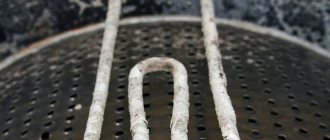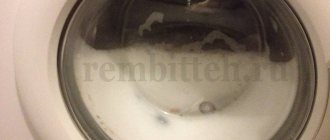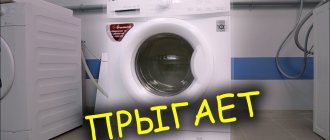Thanks to the efforts of manufacturers, automatic washing machines are highly reliable and owners do not even suspect that the washing machine may someday fail. Therefore, in situations where the washing machine stops during washing, many users do not even know what to do. Calling a technician from the service center will certainly solve the problem, but the workshop is not always nearby, and specialist visits are scheduled almost a month in advance. Therefore, you first need to try to fix the problem yourself, because the machine does not always stop washing due to serious malfunctions. In the event of an unexpected stop of the washing machine, first of all you need to make sure that there is electricity and water, and that there is no blockage in the sewer. Very often, overloading of the machine drum and software failures cause the washing to stop.
If the program on the washing machine has gone wrong. What to do
If everything is in order with the communications, and there is no excess laundry loaded into the drum, you need to check whether the washing machine program has failed. To do this, just “reboot” the washing machine by following a few simple steps:
- unplug the washing machine from the socket;
- wait a few minutes;
- insert the plug back;
- restart the interrupted wash program.
If the reason for the stop was a program failure in the Indesit washing machine or a washing machine of another brand, the machine will start the selected mode and completely complete the washing cycle. In the future, the washing machine will work as before and there is no need to call a technician. Failures most often occur due to voltage changes in the electrical network or changes in pressure in the water supply. But if the machine stopped not because the program on the washing machine went wrong, we’ll look at what to do next in more detail.
Three operating errors leading to no spin
Any housewife will be upset if her favorite washing “assistant” does not spin. Washing laundry by hand, especially if it is heavy and bulky, is not an easy job. But don’t rush to start it!
Spin is the final stage of washing. But it is not provided for by any washing program. Sometimes the spin is performed only partially (at minimum drum speed), sometimes it is not performed at all. In the latter case, the water simply drains from the machine, and the laundry remains very wet.
If, upon opening the hatch door, you find that the laundry is floating in a small amount of water, check the wash program settings. Perhaps it does not involve spinning. Such programs are:
- sensitive,
- delicate,
- careful,
- washing fine linen,
- silk,
- wool, others.
It may be that the “Spin” mode was turned off manually by someone in the household.
To spin the laundry in these cases, simply reset the control panel control to spin mode and start the process by pressing the “Start” button.
We invite you to familiarize yourself with Russian Titanium Glue, instructions for use – Titanium Glue – application and characteristics
If you have selected a program that includes a spin cycle, check two more possible operating errors:
- Washing machine imbalance.
- Exceeding the maximum possible weight load.
Some washing machines report this in case of imbalance or overload by displaying an error code on the display. Other units simply stop working and do not spin the laundry.
Imbalance and overload are dangerous for the washing machine, so, to protect itself and its owner, it stops working without carrying out the most active stage of washing - spinning clothes at high drum speeds.
Imbalance - a violation of the distribution of laundry in the drum of the washing machine (clumped into a lump or loaded in a stack).
To eliminate the imbalance, just open the machine and distribute the laundry evenly.
Overloading with weight is even easier to eliminate. Some of the loaded laundry is removed from the machine.
So, remove some of the laundry or redistribute it in the washing machine and try spinning.
What to do if the washing machine stops during washing
Usually, after an emergency stop, an error code appears on the washer display indicating a faulty unit. But sometimes the washing machine freezes, the timer shows the time until the end of the wash, but nothing else happens (the drum does not rotate, the water does not drain or enter the tank, and the timer readings do not change). In such situations, you need to pay attention to the displayed time. When the machine stops at the beginning of the cycle, there may be a malfunction of the water tank filling system, heating element or electric motor. But if the washing process is at the final stage or the washing machine freezes at the last minute, there is probably a problem when performing one of the subroutines: rinsing, draining or spinning.
Troubleshooting
When you sequentially check all the details listed above, you will definitely find an element due to which the Samsung washing machine does not spin out the laundry.
As a rule, to eliminate a malfunction, you need to replace the damaged element. However, if the impeller is damaged, you can only replace it, and not the entire pump.
We suggest you familiarize yourself with How to wash floors? 21 photos How to wash quickly and without streaks with a disinfectant, how to wash sunflower oil, how to properly clean the coating with salt and vinegar
If you cannot find a suitable impeller, you will have to purchase a new pump.
Sometimes it is possible to repair a faulty pressure switch by replacing its electrical part.
So, Samsung washing equipment may not spin for many reasons, ranging from simple user errors to serious malfunctions. In any case, it is better to fix the breakdown immediately.
You may also be interested in reading:
- Samsung washing machine shows error h1 - what to do?
- Samsung washing machine does not spin or drain water - reasons
- How to clean a washing machine drain hose
- How to remove the top cover of a Samsung washing machine
What to do when the washing machine stops rinsing
If the washing machine does not proceed to rinse and spin, you need to determine what is preventing the program from moving to the next washing stage. The operating algorithm of the washing machine provides that before rinsing, the water from the tank is drained and clean water is collected. Therefore, most often the culprit of the stop is problems with drainage, since the tank filling system worked at previous stages of washing or a breakdown in the control board. To make sure that the drain unit is working properly, you need to reset the installed program and enable the drain mode separately (in each model this option is implemented differently and you will find how to do this in your washing machine in the description). If the washing machine freezes and refuses to drain water, you need to check the components of the drainage system:
- drain filter;
- drain pump;
- drain hose;
- internal pipes.
But first you need to disconnect the washing machine from the electricity and water supply and drain the water manually through the emergency drain tube, filter cover or drain hose lowered below the tank level. If water drains normally through the filter, but does not leave through the drain hose, you need to study the information on how to change the drain hose in a washing machine and install a new one yourself. It is also necessary to check the serviceability of the pump. Usually, when working, it makes characteristic sounds. If the pump is silent, check the voltage at its terminals with a tester or multimeter. If it does, the pump needs to be replaced. In cases where the components of the drainage unit are normal, but the washing machine still stops rinsing, there is probably a problem with the control controller and you need to contact a workshop.
Technical problems
Not every person without special education will be able to cope with such a problem as a motor breakdown, heating element burnout, belt breakage, or failure of sensors and pumps. In these cases, it is better to entrust the repair of the machine to professionals who, using special instruments, will conduct the necessary research and competently eliminate the malfunction.
Engine malfunction
A failed engine is one of the breakdowns that will cause the unit to freeze immediately after turning on the program. Modern washing machines are equipped with an inverter motor, which hardly breaks down. But with a commutator motor all sorts of troubles often happen. For example, with frequent use of the device, the electric brushes wear out and are destroyed, which will need to be replaced. The stator winding may break, causing the motor to stop or even burn out. In this case, the entire engine will need to be replaced.
The following factors indicate a motor malfunction:
- when starting, it knocks out the plugs in the shield;
- noise and crackling during operation;
- the engine turns off due to overheating;
- The washing machine does not start.
In extreme cases, when the unit is turned on, smoke and a burning smell may appear, which indicates a problem with the engine. You must immediately disconnect the device from the network, drain the water (if the machine has managed to fill it up) and call a technician.
Belt
All stages of washing take place with a rotating drum. Rotation is impossible without a belt, with which the centrifuge is attached to a pulley connected to the engine of the device. It is especially noticeable that the drum has stopped spinning during the spin cycle. The culprit for this malfunction may be a torn or flying belt. The belt can become unusable both from prolonged use and as a result of drying out during a long period of inactivity of the device.
It is very simple to verify your suspicions - you need to rotate the tank by hand in an empty machine. If there are problems with the belt, it rotates freely, but remains motionless when the device is running. To correct the situation, you need to replace the belt.
Tena
Every washing machine involves heating water, for which a heating element (tubular electric heater) is responsible. This part can fail due to accumulated limescale, frequent power outages, and, finally, simply from old age.
If the heating element fails, the machine may stop working at any stage of the wash, freezing at one time, but most often this happens when switching to rinsing. You can make sure that the water is not heating up by looking at the glass of the door. It will be cold. To leave no doubt as to the reason for the device stopping, you need to test the electrical circuit with a multimeter. The problem is solved by installing a new heating element.
Sensors
All the main processes occurring during the operation of the washing machine are controlled by sensors. If one of them breaks down, the head module does not receive the necessary information, the program crashes, and the machine begins to “strange”: it does not switch modes, does not drain water, does not spin the drum, and so on.
The washing machine has the following sensors.
- Pressostat is a pressure switch, also known as a water level sensor. Controls the amount of water in the tank and prevents overfilling.
- Water temperature sensor - located separately in the tank or built into the heating element.
- Sensor for measuring drum rotation speed.
- Aquasensor - determines the purity of water.
If one of the sensors fails, it needs to be replaced.
Electronic module
The electronic module is the most complex part of the washing machine. It is an electronic board with machine control elements arranged in a special order, the operation of which is directed and synchronized by a microprocessor.
It is important to determine in a timely manner that it is the control module of the machine that is faulty, and not its other parts. Otherwise, you can spend a lot of money replacing the processor, but the failure will remain in place.
The following signs indicate problems with the control module:
- the machine does not respond to user actions;
- does not start the wash and does not allow you to switch programs, the indicators flash randomly;
- does not collect water after starting the wash or drains spontaneously;
- can wash two to three times more than the allotted time;
- The heating element either heats the water too much or leaves it absolutely cold.
If you suspect a faulty control module, it is better to immediately contact a specialist. This is a very serious breakdown, the detection and correction of which requires knowledge and ability to handle special devices. The board can be reflashed or burned transistors and resistors can be replaced. If the microprocessor is damaged, it will have to be replaced.
UBL
The hatch locking device is one of the most important parts that ensures the safe operation of the device. After the housewife has loaded the laundry and turned on the desired mode, the UBL locks the door and signals the control module that work can begin. Without this signal, washing will not take place.
The locking device, like other electrical parts, can become damaged due to frequent power surges or prolonged use. If a malfunction is detected, the UBL must be repaired or replaced with a new part.
Pumps
A common reason for a washing machine getting stuck on one program is a faulty drain pump. Typically, this problem occurs when the device is used for a long time, when the pump motor wears out and burns out. Foreign objects that get into the drain pump from clothing pockets can break the motor blades, causing the entire unit to fail. One way or another, if the pump does not work, it must be replaced.
A washing machine is a complex household appliance, and if it stops switching, freezes during rinsing or spinning, or does not drain water, then there is some kind of malfunction. Some breakdowns can be fixed with your own hands, but most often you have to go to a workshop. Therefore, it is good when the machine has a manufacturer’s warranty.
If the washing machine is stuck on the spin cycle, what should you do?
First of all, check your wash settings. In some modes, spinning is either not provided at all or is turned on manually after a long soaking (rinsing). Start the cycle manually and wait until the wash finishes.
One of the frequent failures during the operation of washing machines is the situation when the washing machine freezes at one time each time, and this time period corresponds to the beginning of the spin cycle. This may be caused by:
- insufficient or excessive loading of the drum with laundry;
- loading one too heavy or bulky item;
- jamming of the drum with a foreign object.
If the washing machine stops during washing for these reasons, it will not be difficult for an experienced owner to fix them without calling a service center specialist.
The washing machine froze during the spin cycle. Major breakdowns
In addition to the reasons that are most often attributed to user errors, failure of the washing machine components can also lead to situations where the washing machine freezes on the spin cycle. It can be:
- a failed pressure switch (water level sensor), which does not confirm the absence of water in the tank and the control board does not issue a command to move to the next step of the washing program (spin).
- malfunction of the balance sensor (not installed on all models);
- wear of the damper or shock absorber of the washing machine, which leads to increased vibration and activation of the protection;
- stretched drive belt;
- bearing corrosion (the drum cannot reach the required speed);
- breakdown of the tachometer that controls the speed of the electric motor. The control board has no information about the armature rotation speed and stops washing;
- problems with drainage (described in the previous section);
- malfunction of control board elements.
Usually, the above-described malfunctions are eliminated by service center specialists, since disassembling the washing machine and skills in working with equipment are required.
If you find an error, please select a piece of text and press Ctrl+Enter.
Troubleshooting
What to do if your Samsung washing machine does not spin clothes? Spinning may not occur if technical problems occur. To find out the cause of the breakdown, you need to perform a sequence of actions.
It is advisable to check the machine parts in the following order:
- Water pump;
- Tacho sensor;
- Electric motor;
- Pressostat;
- Control module.
So, the check needs to start with the pump, tachometer and electric motor.
To do this you need:
- Shut off the water supply.
- Disconnect the machine from the water supply and sewer system.
- Remove the device from the place in which it is installed.
- Remove the powder receptacle.
- Carefully place the machine on its left side. This will prevent water from leaking onto the electrical elements of the washing machine.
- Remove the pallet. This work must be done carefully. The leakage sensor wire should remain undamaged.
- Next you need to find the pipe that goes from the machine tank to the pump. Remove the plastic clamps securing this pipe.
- Remove the pipe and check its condition. It should not contain dirt or other objects.
- The pump is held in place with screws. You need to unscrew them and then remove the pump itself.
- Check the condition of the pump. There should be no damage to it. You also need to carefully inspect the impeller.
We measure the resistance at the contacts of the dismantled pump. This is done using a multimeter. A three-digit number will appear on the device screen if the pump is working.
Next you need to check the tachometer. It is a small device. Externally, the tachometer looks like a ring from which wires stick out.
This part is located on the electric motor. Its purpose is to transmit data on the intensity of rotation of moving engine parts to the control module. Spinning laundry without this part is impossible.
We suggest you familiarize yourself with the washing machine shaking, jumping and vibrating strongly during the spin cycle
First you need to disconnect the tachometer wires. Next, you need to remove the sensor itself from the washing machine motor. Using a multimeter, we check the resistance and determine the serviceability of the part.
Next you need to disconnect the wires from the motor. You need to work carefully. Then remove the drive belt from the pulley.
It is recommended to take a photo of the wiring location on the motor. This will greatly simplify the subsequent installation of the engine in its original place.
Next, you need to unscrew the fasteners securing the electric motor, and then carefully pull it out. First of all, you need to remove and check the condition of the brushes, since they very often fail.
Use a multimeter to check the winding resistance. If the winding is broken, the motor most likely cannot be restored. Of course, you can give it to a master who will rewind it. However, such repairs will cost almost the same as a new engine. It's easier to buy a new motor.
The next step is to check the pressure switch. If this sensor malfunctions, the machine will not be able to spin the laundry. After all, the control module does not receive information about the water level in the tank and freezes until the laundry starts spinning.
To get to this sensor, you will have to remove the top cover. Under the lid there is a plastic washer with a tube. This is a pressure switch. You need to disconnect the wiring from the sensor and carefully remove it. The main part of the pressure switch is made of plastic. However, it also contains an electrical part. You need to check it with a multimeter. You also need to blow out the pressure switch tube.










